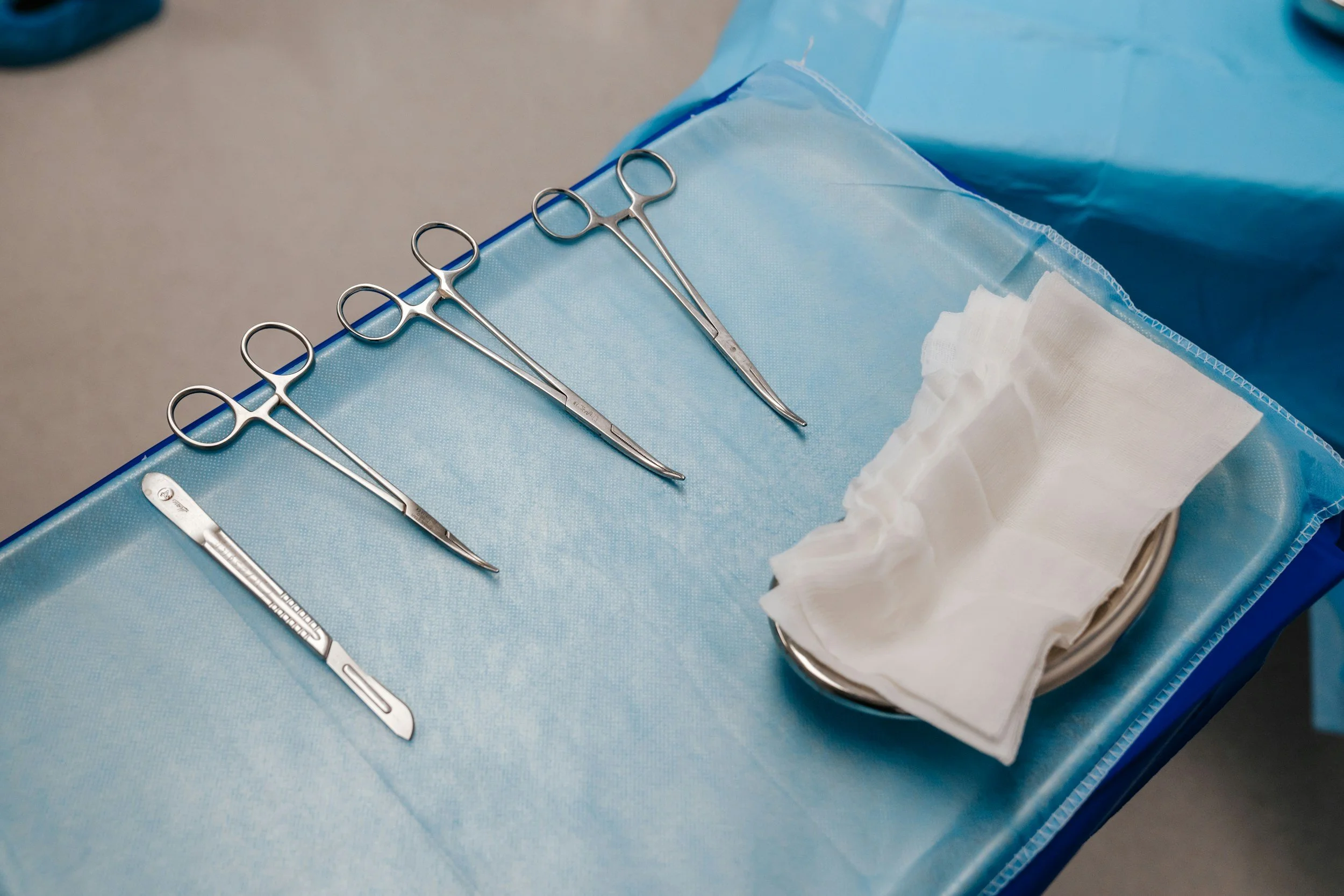
Reconstruction after Skin Surgery—In Network Care
3 days a week, I help fix the skin on the face and body after Mohs surgery, with my partner, Dr. Raijv Kwatra. For plastic surgery repair after skin cancer removal, I am on most major insurance plans in Arizona.
What Is Mohs Surgery?
Mohs surgery is a way specialized skin surgeons remove certain skin cancers—mainly basal and squamous cell types—by taking off the skin in thin layers and checking each one under a microscope until no cancer is left.
Why is it Used?
It’s especially good when the cancer is in a spot where saving healthy skin matters—like your eyelid, nose, or lip. It helps remove as little normal skin as possible while making sure all the cancer is gone.
How It Works—Step by Step
You get numbed (you stay awake).
Dr. Kwatra cuts out the visible cancer and a tiny bit of regular skin.
That tissue gets prepared and checked under a microscope. Each layer takes up to 1.5 hours to process
If cancer is still there, they remove another thin layer from exactly that spot and check again. Repeat until it’s all clear.
Once all cancer is gone, I repair the hole left behind after cancer removal.
Why It’s Great
Most people are cancer‑free after just 1 or 2 rounds—some studies say cure rates reach up to 99% for new skin cancers. It’s the gold‑standard when you need to protect healthy skin and get the job done right.
Risks (Because Nothing’s Perfect)
Bleeding, bruising, and pain
There will be a scar (surprise!), but I try to minimize it as much as possible.
Rarely, infections or problems healing can happen.
A second surgery can be necessary to touch up the first closure.
What Makes This Clinic Special
At Dermatology Associates, Dr. Kwatra has extra training in Mohs surgery and belongs to the American College of Mohs Surgery. Here, our team is one of the only clinics to offer same day, in-house plastic surgery repair of your wound with ME!
✨ What to Expect After Mohs Surgery and Repair
Healing after facial surgery follows a natural course. Knowing what’s normal—and how to care for yourself—can make the journey smoother and less stressful.
The Normal Healing Course
Pain & Swelling
Expect both pain and swelling to increase during the first 3 days.
After day 3, they should steadily improve.
Taking pain medication early and on schedule reduces the overall burden of pain.
Bruising & Drainage
Bruising often moves downward along the face and may last 2 weeks or more.
Light, blood-tinged drainage (“bloody tears” or mild oozing) is normal for 5–7 days.
How to Help Your Recovery
First 3 Days
Apply ice packs frequently while awake to minimize swelling and bleeding.
After Day 3
Switch to warm compresses to reduce crusting and encourage healing.
Clean the incision gently with baby shampoo and pat dry.
Do not rub or pick at stitches.
Activity
Sleep with your head slightly elevated and avoid lying directly on the wound.
Showers are safe after 24 hours, but avoid baths, hot tubs, and swimming.
Limit strenuous activity for 1 week. Wait before golfing, yoga, or heavy lifting—anything that raises pressure in the head or chest can cause bleeding.
Medications
You may take Tylenol or Advil the evening after surgery.
Blood thinners can usually be resumed 48 hours after surgery, unless otherwise directed.
Stitches, Staples, and Healing
Dissolving Stitches (Sutures):
Most facial procedures use two layers of stitches.
Deep stitches (Vicryl) hold the wound underneath and dissolve slowly over weeks to months.
Surface stitches are finer and dissolve on their own, helping skin edges heal smoothly.
Staples:
Occasionally used in the scalp where hair complicates closure.
Must be removed in the office 21–28 days after surgery.
If Stitches Remain:
Rarely, a dissolving stitch lingers at the skin surface.
If this happens and you feel comfortable, you may trim it with clean, sharp scissors (such as nose-hair scissors) and tweezers.
Never remove stitches before 2 weeks.
Wound Care After Surgery
Hypochlorous Acid Spray:
Topical Growth Factor:
Applying epidermal growth factor (EGF) serum may help wounds heal faster and more smoothly.
Gentle Cleansing:
Baby shampoo helps keep the wound free of crust. Wash 3x daily. Wash gently and pat dry.
Moisture is Key:
Wounds heal best when kept moist, not dry.
The simplest and most effective dressing is plain Vaseline, applied in a thin layer to protect and speed healing. Vaseline coated gauze is also available if you want/need.
When to Call the Office
Pain or swelling that worsens after day 3 instead of improving.
Sudden vision changes, severe bleeding, or rapidly increasing swelling.
Signs of infection: new redness, pus, warmth, or fever.
Any concern that “just doesn’t look right.”
You may also text us a photo for quick guidance.
📞 Our phone number: 602-230-6744
Paramedian Forehead Flap
A patient-friendly guide
What is it?
A paramedian forehead flap uses skin from the forehead, rotated down while keeping its blood supply, to rebuild part of the nose. This is often needed after skin cancer removal or trauma. Forehead skin matches nasal skin in color and texture, so it blends naturally.
Why is it used?
Best color and texture match for the nose
Reliable blood supply for healing
Allows repair of larger or more complex nasal wounds
The Stages of Surgery
Stage 1: Placement
Forehead skin is rotated and attached to the nose.
The flap looks bulky and has a visible “bridge” for blood supply.
This look is temporary.
Stage 2: Shaping (about 3–4 weeks later)
The flap is thinned and sculpted to match the nose.
Stage 3: Final refinements (if needed)
The bridge is divided and final contouring is done.
Some patients complete surgery in two stages instead of three.
Alternatives
Local flaps: Tissue moved from near the nose (bilobed, nasolabial). Works for smaller wounds.
Skin grafts: Thin skin from behind the ear or elsewhere. May not match perfectly.
Healing naturally: Very small concave areas sometimes heal well on their own.
What to Expect After Surgery
Bruising and swelling for 2–3 weeks.
Visible skin bridge between stages.
Forehead scar fades with time.
Pain usually mild, controlled with simple medication.
The “Unfinished” Look Between Stages
Stage 1 is intentionally bulky and may look shocking at first. This can affect how you feel about being in public, talking with others, or even looking in the mirror.
Tips to cope:
Prepare a simple explanation: “I’m in between stages of a nose reconstruction after removing skin cancer. This is temporary.”
Use hats, glasses, or light tape to help cover.
Consider reducing public-facing work for a few weeks.
Children: show them a photo and explain, “This is helping my nose heal.”
Social media/photos: wait until after Stage 2 if you feel self-conscious.
Remember: Stage 2 brings a big cosmetic improvement. Final shaping continues for months, but the bulky bridge is temporary.
Care Basics
Keep dressings clean and dry.
Apply ointment if directed.
Cold compresses in the first 48 hours.
Sleep with head elevated for 1 week.
Avoid strenuous activity for about 2 weeks.
Protect from sun with hat and sunscreen once healed.
Summary
The paramedian forehead flap is the gold standard for rebuilding larger nasal defects. The in-between appearance is temporary. Alternatives exist, but for bigger wounds this option offers the best chance for natural color, shape, and function.

